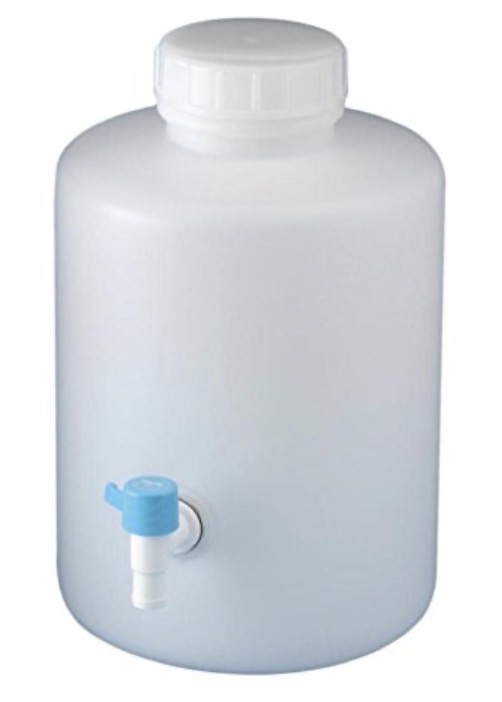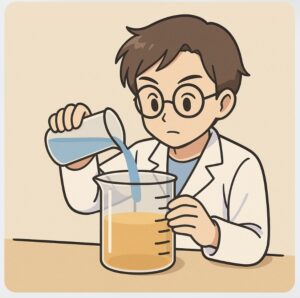“Lungs Don’t Inflate on Their Own!?” Learning How We Breathe with a PET Bottle Model (Diaphragm and Lungs)
I’m Ken Kuwako, a science trainer. Every day is an experiment.

【Read this article in English】
When it comes to “detecting carbon dioxide” in a science class, calcium hydroxide solution is a familiar sight. But are there teachers who buy commercially available calcium hydroxide solution every time? Of course, buying it is one way to save time and effort. However, calcium hydroxide solution is actually very easy to make yourself!
【This article is also available as a podcast. Please listen here.】
After all, most of the components are water. Buying, transporting, and storing it is a bit of a waste of time and space. It’s quicker, cheaper, and gives you more freedom in your lessons if you just make it yourself!
Here, we’ll show you how we usually make calcium hydroxide solution at school. It’s a method that’s easy to do in a science lab, so please give it a try!
Even in the labs at my school, we make our own. We make it in a tank, but the method described on the old “Rika Network” (which is no longer viewable) is simple enough for any lab. By the way, there are also special containers sold for collecting calcium hydroxide solution, called “calcium hydroxide solution collection bottles,” which have a tap a little higher up to make it easier to get the supernatant liquid.
Here’s the Rakuten link.
|
|
For the preparation method, we’ll quote from “Rika Network.” The following is the information that was (or is) on the Rika Network website (which is no longer viewable).
Calcium hydroxide dissolves only about 0.16g in 100g of water at 25°C. To make calcium hydroxide solution, add a large amount (50g or more) of calcium hydroxide to 500cm3 of water, stir well, and leave it covered and undisturbed for 2 days to a week. The undissolved calcium hydroxide will settle to the bottom. Use the supernatant liquid.
Amazon Calcium Hydroxide
Rakuten Slaked Lime 10kg【Calcium Hydroxide】
Store in a sealed container.
As it is an alkaline chemical, be careful not to get it on your skin or in your eyes, nose, or mouth. Use safety goggles when handling. Do not mistake slaked lime (calcium hydroxide) for quicklime (calcium oxide, used in desiccants). Adding water to quicklime generates a large amount of heat and is dangerous. If it gets in your eyes or nose, wash thoroughly with plenty of running water and seek medical attention immediately. If swallowed, rinse your mouth well.
Dispose of slaked lime as non-burnable waste, and dilute calcium hydroxide solution with a large amount of water before disposal.
We received an inquiry about why you need 50g or more of calcium hydroxide for 500mL of water, even though only about 0.16g dissolves in 100g of water (it seems like 0.16 × 5 = 2.4g should be enough).
One reason is that putting in more makes it easier to dissolve. Another reason is the convenience of being able to reuse it multiple times; if the solution runs low, you can just add more water and stir, and you’ll have more calcium hydroxide solution eventually. That’s why we put in a generous amount and use the supernatant.
Also, when adding water, fill the container to the brim to minimize contact with carbon dioxide in the air. If it comes into contact, a chemical reaction will cause calcium carbonate to form a film on the surface.
Another useful reference site is from the Saga Education Center. As for the disposal of calcium hydroxide solution, it is safer to neutralize it with hydrochloric acid or another acid before discarding it.
While calcium hydroxide solution is sold by educational supply companies, it’s mostly water, so it feels like a waste of money. It’s better to make it yourself and use the remaining budget for other things. According to this site, you can even make calcium hydroxide solution from the desiccant found in nori (seaweed) packages. Really? I might have to try that sometime.
◆ Conclusion
Teachers who are used to buying calcium hydroxide solution are oftensurprised to find how easy it is to make it themselves.Since you can do it with materials already in the lab, please give it a try the next time you’re preparing for a class.A little bit of ingenuity and a little extra effort can make science class more accessible and fun!
About Inquiries and Requests
Making the wonders and fun of science more accessible! I’ve summarized fun science experiments that can be done at home and the tips for doing them. Please search around!
・To learn about the author, Ken Kuwako, click here
・For various requests (writing, lectures, experiment classes, TV supervision, appearances, etc.), click here
・Article updates are posted on X! Follow for the latest information
![]() The Science Channel is broadcasting experiment videos!
The Science Channel is broadcasting experiment videos!





